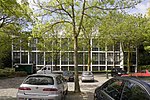University College Maastricht

University College Maastricht (UCM) is an English language, internationally oriented, liberal arts and sciences college housed in the 15th century Nieuwenhof monastery in Maastricht, Netherlands. Founded in 2002, it is the second of its kind in the Netherlands. The college is part of Maastricht University (Dutch: Universiteit Maastricht) and offers a selective honours programme with a high workload. The Dutch Higher Education Guide (Keuzegids Hoger Onderwijs) ranked UCM the best bachelors programme in the Netherlands in 2015 and 2016; in 2012, 2014 and 2015 they ranked UCM the best university college in the Netherlands. In 2012, 2013, 2014, 2016 and 2018 Elsevier Magazine ranked UCM the best university college in the Netherlands in terms of student satisfaction.
Excerpt from the Wikipedia article University College Maastricht (License: CC BY-SA 3.0, Authors, Images).University College Maastricht
Zwingelput, Maastricht
Geographical coordinates (GPS) Address Nearby Places Show on map
Geographical coordinates (GPS)
| Latitude | Longitude |
|---|---|
| N 50.8443 ° | E 5.6886 ° |
Address
University College Maastricht
Zwingelput
6211 KH Maastricht
Limburg, Netherlands
Open on Google Maps










